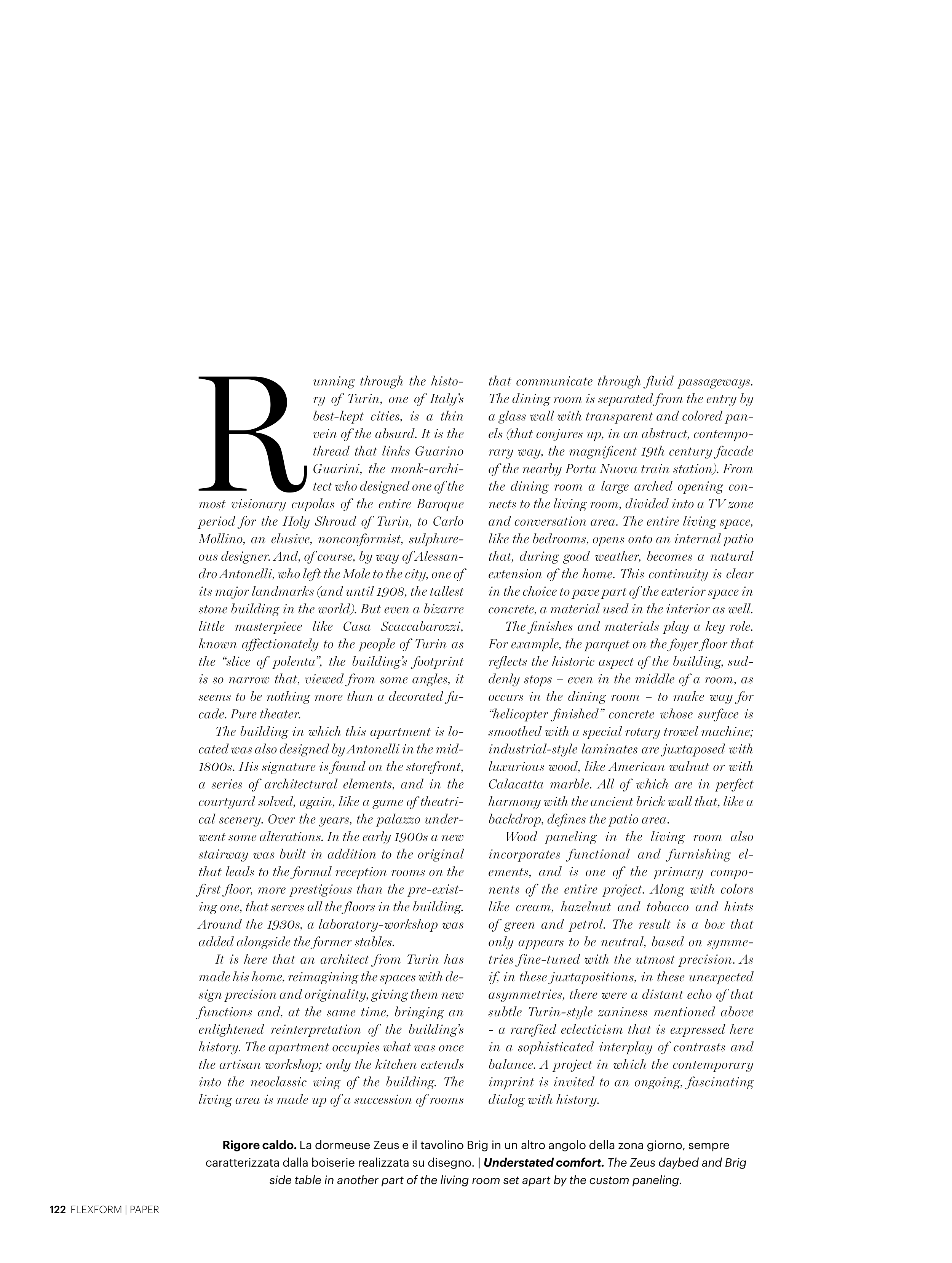122 FLEXFORM | PAPER
Rigore caldo. La dormeuse Zeus e il tavolino Brig in un altro angolo della zona giorno, sempre
caratterizzata dalla boiserie realizzata su disegno. | Understated comfort. The Zeus daybed and Brig
side table in another part of the living room set apart by the custom paneling.
R
unning through the histo-
ry of Turin, one of Italy’s
best-kept cities, is a thin
vein of the absurd. It is the
thread that links Guarino
Guarini, the monk-archi-
tect who designed one of the
most visionary cupolas of the entire Baroque
period for the Holy Shroud of Turin, to Carlo
Mollino, an elusive, nonconformist, sulphure-
ous designer. And, of course, by way of Alessan-
dro Antonelli, who left the Mole to the city, one of
its major landmarks (and until 1908, the tallest
stone building in the world). But even a bizarre
little masterpiece like Casa Scaccabarozzi,
known affectionately to the people of Turin as
the “slice of polenta”, the building’s footprint
is so narrow that, viewed from some angles, it
seems to be nothing more than a decorated fa-
cade. Pure theater.
The building in which this apartment is lo-
cated was also designed by Antonelli in the mid-
1800s. His signature is found on the storefront,
a series of architectural elements, and in the
courtyard solved, again, like a game of theatri-
cal scenery. Over the years, the palazzo under-
went some alterations. In the early 1900s a new
stairway was built in addition to the original
that leads to the formal reception rooms on the
first floor, more prestigious than the pre-exist-
ing one, that serves all the floors in the building.
Around the 1930s, a laboratory-workshop was
added alongside the former stables.
It is here that an architect from Turin has
made his home, reimagining the spaces with de-
sign precision and originality, giving them new
functions and, at the same time, bringing an
enlightened reinterpretation of the building’s
history. The apartment occupies what was once
the artisan workshop; only the kitchen extends
into the neoclassic wing of the building. The
living area is made up of a succession of rooms
that communicate through fluid passageways.
The dining room is separated from the entry by
a glass wall with transparent and colored pan-
els (that conjures up, in an abstract, contempo-
rary way, the magnificent 19th century facade
of the nearby Porta Nuova train station). From
the dining room a large arched opening con-
nects to the living room, divided into a TV zone
and conversation area. The entire living space,
like the bedrooms, opens onto an internal patio
that, during good weather, becomes a natural
extension of the home. This continuity is clear
in the choice to pave part of the exterior space in
concrete, a material used in the interior as well.
The finishes and materials play a key role.
For example, the parquet on the foyer floor that
reflects the historic aspect of the building, sud-
denly stops – even in the middle of a room, as
occurs in the dining room – to make way for
“helicopter finished” concrete whose surface is
smoothed with a special rotary trowel machine;
industrial-style laminates are juxtaposed with
luxurious wood, like American walnut or with
Calacatta marble. All of which are in perfect
harmony with the ancient brick wall that, like a
backdrop, defines the patio area.
Wood paneling in the living room also
incorporates functional and furnishing el-
ements, and is one of the primary compo-
nents of the entire project. Along with colors
like cream, hazelnut and tobacco and hints
of green and petrol. The result is a box that
only appears to be neutral, based on symme-
tries fine-tuned with the utmost precision. As
if, in these juxtapositions, in these unexpected
asymmetries, there were a distant echo of that
subtle Turin-style zaniness mentioned above
- a rarefied eclecticism that is expressed here
in a sophisticated interplay of contrasts and
balance. A project in which the contemporary
imprint is invited to an ongoing, fascinating
dialog with history.


























































































































































































































































